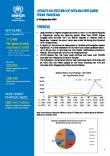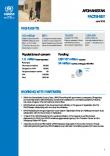Afghanistan
Operation: Afghanistan
Location
{"longitude":65,"latitude":34,"zoom_level":0}
Latest update of camps and office locations 13 Jan 2016. By clicking on the icons on the map, additional information is displayed.
Key Figures
| 2015 end-year results | |
| 58,000 | refugee returnees were supported with cash grants to help them settle back in Afghanistan |
| 56,000 | returnee, IDP and refugee families were supported with winterization assistance |
| 30,000 | newly displaced IDP families were provided with emergency assistance |
| 15,000 | returnee, IDP and refugee families received shelter support |
| 2016 planning figures | |
| 172,000 | people of concern receiving cash grants (returnees) |
| 100% | of refugees registered on an individual basis |
| 146,500 | households receiving core relief items (IDPs) |
Latest Updates
September - December 2016
Last Updated 26 September 2016
Last Updated 18 September 2016
June 2016
People of Concern
33%
Increase in
2015
2015
| 2015 | 1,767,291 |
| 2014 | 1,324,996 |
| 2013 | 985,197 |

[["Refugees",237069],["Refugee-like situation",20485],["Asylum-seekers",82],["IDPs",1174306],["Returned IDPs",123653],["Returned refugees",61379],["Others of concern",150317]]
Loading ...
Budgets and Expenditure for Afghanistan
< Back
2015
{"categories":[2012,2013,2014,2015,2016],"budget":[139.66510505,131.37522619,151.97085579,150.64388639,137.73386476],"expenditure":[87.36351513,63.92581611,64.25946191,70.35477096,null]}
{"categories":[2012,2013,2014,2015,2016],"p1":[43.42574716,38.23178704,58.44455712,66.83857405,61.46538491],"p2":[null,null,null,null,null],"p3":[77.61677607,65.79076549,60.08470407,56.92509855,52.43562762],"p4":[18.62258182,27.35267366,33.4415946,26.88021379,23.83285223]}
{"categories":[2012,2013,2014,2015,2016],"p1":[33.26558041,18.32759334,25.27108431,42.22418797,null],"p2":[null,null,null,null,null],"p3":[40.66408206,30.54190771,24.42136004,17.78314669,null],"p4":[13.43385266,15.05631506,14.56701756,10.3474363,null]}
Loading ...
CHOOSE A YEAR
- 2014
- 2015
- 2016
Working environment
- The National Unity Government, formed in 2014, demonstrated a strong commitment to addressing issues of displacement throughout 2015. The Government developed a national comprehensive voluntary repatriation and reintegration strategy and established a ministerial-level High Commission on Migration, chaired by the President to coordinate its implementation.
- Despite these positive political developments, the situation in Afghanistan remained complex. 2015 witnessed the highest number of civilian casualties since 2009 and saw a dramatic increase in conflict-induced displacement. Over 380,000 IDPs were newly displaced as a result of conflict in 31 out of 34 provinces– a 70 per cent increase from the previous year – bringing the total number of IDPs in Afghanistan to nearly 1.2 million. Increasing insecurity coupled with drastic economic contractions led many Afghans to seek better lives elsewhere, including in Europe. Afghans were the second largest group of asylum-seekers in Europe after Syrians.
- While there was an overall increase in the number of returns to Afghanistan in early 2015 from major hosting countries in the region, this trend slowed in the second half of 2015, as growing insecurity in many parts of Afghanistan jeopardized opportunities for returnees to safely re-establish themselves in areas of return.
- Afghanistan continued to host 236,950 refugees from Pakistan’s North Waziristan. UNHCR launched an enhanced verification exercise to increase the accuracy of the population data, obtain key information on household vulnerabilities, protection risks and solutions prospects.
Population trends
- Over 58,000 Afghan refugees returned under UNHCR’s assisted voluntary repatriation programme.
- Over 380,000 new conflict-induced IDPs were displaced in 2015, bringing the number of internally displaced population up to 1.2 million.
- Communities in Afghanistan’s Khost and Paktika Provinces continued to host approximately 236,950 refugees (38,666 families) from Pakistan’s North Waziristan.
Achievements and impact
- A new portfolio of projects within the Solutions Strategy for Afghan Refugees (SSAR), developed by the Government with the support of UNHCR, was launched during the high-level segment of the Executive Committee on the Afghan refugee situation in October 2015. It offers a comprehensive and integrated framework for joint interventions aimed at facilitating voluntary return and sustainable reintegration. UNHCR also continued to advocate for the inclusion of returnees and IDPs in national priority programmes and development planning.
- An enhanced returnee monitoring programme, launched in 2015, provided a better understanding of the protection risks and reintegration challenges that returnees face in the initial phases of return in a complex and insecure environment.
- UNHCR continued to lead the protection and emergency shelter/non-food items clusters under the UN Transformative Agenda. A handover to OCHA of the overall coordination responsibilities on conflict-induced IDPs was initiated.
- Approximately 380,000 conflict-induced IDPs were profiled in accessible areas across the country in 2015 in a joint exercise with members of the IDP Task Force.
- As humanitarian needs rose due to renewed conflict, UNHCR expanded its assistance for people with specific needs, reaching out to the most vulnerable through a network of partners.
Unmet needs
- The needs of protracted IDPs remained largely unmet in 2015.
- Lack of progress in land tenure reform remained an obstacle in providing shelter to returnees.
- Insecurity contributed to the lack of long-term support for sustainable reintegration.
Working environment
It is anticipated that the newly-formed national unity Government will demonstrate commitment to creating an enabling environment for sustainable returns. The withdrawal of international security forces, as well as a complex economic transition are, however, likely to affect peace, security and development in Afghanistan. Humanitarian needs are not expected to diminish in 2015. Support and assistance from the international community will be essential to ensure a transition towards more stable development.The Solutions Strategy for Afghan Refugees (SSAR) remains the main policy framework for sustainable reintegration of those returning to Afghanistan. The National Steering Committee established in 2014 aims to facilitate the implementation and monitoring of the SSAR’s initiatives.
Many returnees have migrated to towns and cities, contributing to the country’s rapid urbanization. As rising poverty and unemployment in urban centres prevent them from reintegrating into society, many will need basic assistance.
Currently, there is no national asylum and refugee legislation in Afghanistan, so UNHCR is conducting refugee status determination (RSD). A draft national refugee and asylum law, prepared with UNHCR assistance, is awaiting inclusion in the 2015 legislation agenda.
The Government of Afghanistan respects the principle of non-refoulement and host communities have provided generous support; however, refugees face protection concerns related to the volatile security situation, and difficulties in accessing basic services.
Insurgency continues to spread from southern Afghanistan to large areas of the north and centre and is likely to remain a threat to stability in 2015. While violence may displace more people, insecurity is likely to continue restricting humanitarian access. Economic insecurity and the Government’s limited capacity to provide basic services are also challenges.
Needs and strategies
The SSAR remains the regional policy framework and aims to enhance the reintegration of refugee returnees by strengthening partnerships with development actors and advocating sustainable solutions for people of concern.Shelter remains the most pressing need for returnees, IDPs and people in a refugee-like situation, particularly in large cities, where land issues are prevalent. Another critical issue throughout Afghanistan is a lack of both drinking and irrigation water.
Scarce resources and limited basic infrastructure are linked to poor employment opportunities, which also affect the sustainable reintegration of Afghan returnees.
Women and girls face challenges in attending school, obtaining identification cards, or participating in local decision-making structures. Standard referral and response mechanisms for survivors of violence do not yet exist in Afghanistan. In rural areas, survivors of sexual and gender-based violence (SGBV) lack psychological and social support. UNHCR has a five-year plan to prevent SGBV in Afghanistan and promote women’s empowerment.





